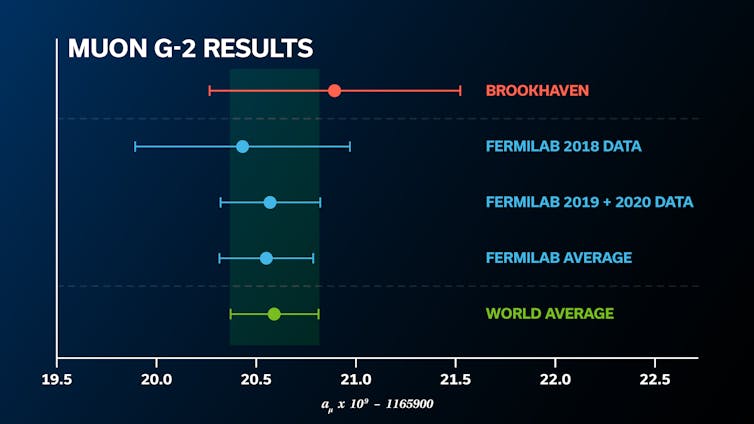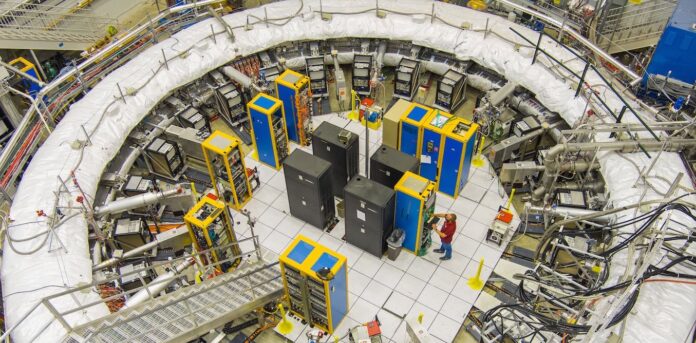Is there new physics beyond the Standard Model of particle physics? Our finding will help settle the question

By Dominika Vasilkova, University of Liverpool; Ce Zhang, University of Liverpool; Elia Bottalico, University of Liverpool, and Saskia Charity, University of Liverpool
Despite its tremendous success in predicting the existence of new particles and forces, the Standard Model of particle physics, designed over 50 years ago to explain the smallest building blocks of nature, isn’t the complete “theory of everything” physicists have been longing for.
The theory has several problems. It neither describes gravity nor the unknown components that make up most of the energy density in the universe: dark matter and dark energy. Particle physicists are therefore on a treasure hunt looking for any possible deviation from “expected” behaviour that could hint at new physics.
Now, our large international team of physicists working at the Muon g-2 experiment at Fermilab in the US, has made a measurement of how a certain fundamental particle wobbles that could have massive impacts on the the status of the Standard Model.
Our result, which has not yet been peer reviewed but has been submitted to Physical Review Letters, backs up results from 2021 and sheds light on a massive puzzle in theoretical physics – for which one possible solution could be new particles or forces influencing the measurement.
One fundamental building block in the Standard Model is the muon, a particle similar to an electron but 200 times more massive. The muon has a long history of revolutionising particle physics – even its discovery was a shock.
Our experiment studies how these particles interact with a 1.45 Tesla magnetic field. This causes the muons to wobble like spinning tops, with the rate of the wobble proportional to the strength of the field.
The experiment produces and stores billions of muons in a 14-metre diameter circular magnet called the storage ring. Eventually, muons decay to electrons, which are counted by detectors around the inside of the ring.
Another quirk of nature means that the number of detected electrons varies proportionately to the rate of the wobble. So counting electrons tells us the rate of the muons’ wobble. And the more electrons you count, the more precise the measurement gets.
The interaction between the muon’s wobble and the field is quantified by a dimensionless constant called “g”, the gyromagnetic ratio. The physicist Paul Dirac predicted its value to be g = 2. But according to quantum mechanics, the theory governing the subatomic world that the Standard Model relies on, is that empty space is filled with “virtual” particles, which appear for a fleeting moment and then disappear again by annihilation.
These particles affect the muon’s interaction with the magnetic field, increasing g to slightly more than 2. This is why the experiment, which studies this difference, is named “g-2”. Any missing pieces in the Standard Model would modify the rate by an amount slightly higher or lower than predicted, making this a powerful search tool for new physics.
A measurement at Brookhaven National Laboratory in the US made waves in 2004 after discovering the wobble was slightly faster than expected, potentially hinting at something new. The value was measured again at Fermilab in April 2021, confirming the original measurement and increasing the size of the gap between experiment and theory.

Now, our new result from Fermilab, using data collected in 2019 and 2020, examines four times as many muons as the 2021 result, cutting the total uncertainty by a factor of two. This makes the measurement the most precise determination of the muon’s wobble ever made.
Boosting accuracy
In practice, the experiment is much more challenging than simply counting muons. While the statistical uncertainty has been reduced, other improvements were needed to make the measurement even more precise. The magnetic field direction determines the axis of the wobble, so keeping the temperature fluctuations of the magnet under control was crucial.
Differences in temperature also cause the magnet pieces to expand and contract, which changes the magnetic field slightly. At our level of accuracy, even a change one thousandth of a millimetre could have a huge effect on the wobble. For this reason, a thermal coat was installed around the ring and a cooling system in the experimental hall.
Another challenge is the fact that muons in the ring do not want to stay on a perfectly circular orbit – rather, they like to swim around and explore all regions of the ring. We therefore upgraded the high-voltage systems that push the beam into the right place.
Conventionally, particle physicists estimate how well two results (for example a theoretical and an experimental one) agree by using a statistical measure called sigma. This can estimate the chances of any difference being a statistical fluke. However, that doesn’t make sense this time, because it is becoming increasingly unclear which Standard Model prediction we should compare the result with.
A collaboration of theorists, called the Muon g-2 Theory Initiative, calculated their value in 2020. That’s what was used in 2021, giving a sigma of 4.2, which suggested the chance that the result was a fluke was one in 40,000. But since then, there have been developments yielding new predictions: one from a novel approach by another group of theorists.
There has also been an updated experimental measurement from the CMD-3 collaboration in Russia that will feed into any new calculations. These could modify the 2020 value, potentially bringing them closer in line with the Standard Model.
It is apparent that there are huge challenges on both sides of the story, where theory doesn’t even agree with theory. Our collaboration is now working towards our final experimental result, expected in 2025, using the entire dataset – over twice as much data. But until the theory controversy is resolved, there will be a cloud of doubt hanging over any interpretation of the discrepancy.
There are two possible outcomes. The theory and experiment may eventually fail to agree, signifying that new particles or forces of nature have been hiding here all along. This could mean that the Standard Model ultimately fails – needing an update. Or, the updated predictions close the gap, which would be a massive boost for the Standard Model.
Either way, our ultra precise measurement sets the stage for the final showdown.![]()
Dominika Vasilkova, Postdoctoral research associate, University of Liverpool; Ce Zhang, Postdoctoral research associate, University of Liverpool; Elia Bottalico, Postdoctoral Research Associate, University of Liverpool, and Saskia Charity, Postdoctoral Research Associate, Particle Physics, University of Liverpool
This article is republished from The Conversation under a Creative Commons license. Read the original article.



